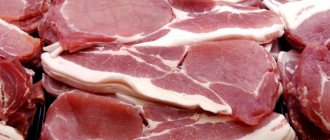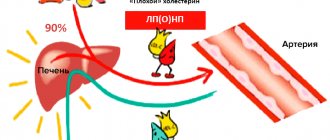The concentration of cholesterol (in chemistry - cholesterol) in the blood is one of the key markers of the state of lipid (fat) metabolism in the body. In clinical hematology, analysis of HDL and LDL cholesterol is performed using a colorimetric, photometric or electrophoretic method.
The study is called a lipidogram, otherwise the lipid profile (status) of the patient. If prescribed by a doctor, indicators of cholesterol metabolism can be included in a detailed biochemical analysis of venous blood.
What are HDL and LDL in cholesterol metabolism?
Cholesterol refers to fat-containing alcohols. The substance is concentrated in cell membranes and serves to protect cells. The body needs cholesterol as a participant in the most important processes that support life:
- hormonal synthesis (steroid and sex hormones);
- production of bile acids;
- absorption of fat-soluble vitamins (A, E, D);
- maintaining pregnancy;
- interaction between the spinal cord and brain.
Cholesterol is divided into two types: exogenous, entering the body with animal fats (butter, meat, milk, etc.); endogenous, produced by liver cells (hepatocytes) inside the body.
Reference: The share of exogenous cholesterol is 20% of the total amount.
Cholesterol, like fat, cannot move through the bloodstream on its own. Once in the blood, its molecules combine with apoprotein proteins and other lipids (triglycerides, phospholipids), forming courier lipoproteins of different densities. The less protein there is in lipoproteins, the lower their density.
20% of cholesterol enters the body with food, and 80% is produced by liver cells
Triglycerides (TG or TG) are formed from fatty foods and are stored in fatty tissues. Essentially, this is the body's lipid reserves, used to replenish energy. Phospholipids are a special type of fat that is not synthesized by the body; they consist of fatty acids, polyhydric alcohols and phosphoric acid and are necessary for the construction of cell membranes.
Types of lipoproteins
Five main types of lipoproteins are involved in cholesterol metabolism.
Accepted classification of lipoproteins and main functions
| Full title | Function | Abbreviation | The average size | |
| Latin | Russian | |||
| low density lipoproteins | transport endogenous cholesterol from the liver to peripheral tissues and cells of the body | LDL | LDL | 18-26 nm |
| very low density lipoproteins | VLDL | VLDL | 30-80 nm | |
| lipoproteins of average (otherwise, intermediate) density | BOB | 25-35 nm | ||
| high density lipoproteins | collects excess LDL and VLDL and delivers them to the liver for excretion | HDL | HDL | 8-11 nm |
| chylomicrons | transport exogenous cholesterol from the intestines to the liver and body tissues | HM | 75-1200 nm | |
LDL and VLDL are positioned as “bad” cholesterol. When moving through arteries and capillaries, they “cling” to microdamages in the intima (the inner layer of the vascular wall) and settle.
A cholesterol stain forms inside the vessel, on the basis of which a cholesterol plaque is subsequently formed, which becomes the cause of atherosclerosis. HDL is called “good” cholesterol because it escorts low-density and very low-density lipoproteins out of blood vessels, preventing them from sticking to the intima.
Components of lipoproteins in percentage
The table shows that chylomicrons and low-density lipoproteins contain the most fat (triglycerides).
High-density lipoproteins are compounds consisting of lipids (fats) and proteins. They ensure the processing and removal of fats from the body, which is why they are called “good cholesterol”.
Synonyms Russian
HDL, high density lipoprotein, HDL, HDL cholesterol, alpha cholesterol.
English synonyms
HDL, HDL-C, HDL Cholesterol, High-density lipoprotein cholesterol, High-density lipoprotein, Alpha-Lipoprotein Cholesterol.
Research method
Colorimetric photometric method.
Units
mmol/l (millimoles per liter).
What biomaterial can be used for research?
Venous blood.
How to properly prepare for research?
- Do not eat for 12 hours before the test.
- Avoid physical and emotional stress and do not smoke for 30 minutes before the test.
General information about the study
Cholesterol (CH, cholesterol) is a fat-like substance vital to the body. The correct scientific name for this substance is “cholesterol” (the ending -ol indicates that it belongs to alcohols), however, the name “cholesterol” has become widespread in the popular literature, which we will use later in this article. Cholesterol is formed in the liver and also enters the body with food, mainly meat and dairy products. Cholesterol is involved in the formation of cell membranes of all organs and tissues of the body. Hormones are created on the basis of cholesterol, which are involved in the growth, development of the body and the implementation of the reproduction function. Bile acids are formed from it, thanks to which fats are absorbed in the intestines.
Cholesterol is insoluble in water, so to move around the body it is “packed” into a protein shell consisting of special proteins - apolipoproteins. The resulting complex (cholesterol + apolipoprotein) is called lipoprotein. Several types of lipoproteins circulate in the blood, differing in the proportions of their components:
- very low density lipoproteins (VLDL),
- low density lipoproteins (LDL),
- high density lipoproteins (HDL).
High-density lipoproteins consist mainly of protein and contain some cholesterol. Their main function is to transport excess cholesterol back to the liver, from where it is excreted as bile acids. Therefore, HDL cholesterol (HDL-C) is also called “good cholesterol.” HDL makes up about 30% of the total cholesterol (cholesterol) in the blood.
If a person has a genetic predisposition to high cholesterol or eats too much fatty foods, the level of cholesterol in the blood may rise so that the excess is not completely eliminated by high-density lipoproteins. It begins to be deposited in the walls of blood vessels in the form of plaques, which can limit the movement of blood through the vessel and also make the vessels more rigid (atherosclerosis), which significantly increases the risk of heart disease (coronary artery disease, heart attack) and stroke.
High levels of HDL cholesterol reduce the risk of developing plaques in blood vessels, as they help remove excess cholesterol from the body. A decrease in HDL cholesterol, even with normal levels of total cholesterol and its fractions, leads to the progression of atherosclerosis.
What is the research used for?
- To assess the risk of developing atherosclerosis and heart problems.
- To monitor the effectiveness of a low-fat diet.
When is the study scheduled?
- An HDL test is performed during routine preventive examinations or when total cholesterol is elevated as part of a lipid profile. It is recommended that all adults over 20 years old have a lipid profile at least once every 5 years. It may be prescribed more frequently (several times a year) if the patient is prescribed a diet limited in animal fats and/or is taking cholesterol-lowering medications. In these cases, it is checked whether the patient achieves the target level of HDL cholesterol and total cholesterol and, accordingly, whether his risk of cardiovascular diseases is reduced.
- With existing risk factors for developing cardiovascular diseases: smoking,
- age (men over 45 years old, women over 55 years old),
- increased blood pressure (140/90 mm Hg and above),
- cases of high cholesterol or cardiovascular diseases in other family members (heart attack or stroke in the closest male relative under 55 years old, female relative under 65 years old),
- existing coronary heart disease, previous myocardial infarction or stroke,
- diabetes,
- excess body weight,
- alcohol abuse,
- eating large amounts of food containing animal fats,
- low physical activity.
What do the results mean?
Reference values
Men: > 1.0 mmol/l.
Women: > 1.2 mmol/l.
The concept of “normal” is not entirely applicable to the level of HDL cholesterol. For different people with different numbers of risk factors, the HDL level will be different. To determine the risk of developing cardiovascular disease more accurately for a specific person, it is necessary to evaluate all predisposing factors. In general, we can say that a reduced level of HDL predisposes to the development of atherosclerosis, and a sufficient or high level prevents this process.
According to clinical guidelines1, when assessing cardiac risk, a level of > 1.0 mmol/L for men and > 1.2 mmol/L for women indicates low risk.
“Diagnostics and correction of lipid metabolism disorders for the purpose of prevention and treatment of atherosclerosis. Russian recommendations, VII revision. 2020".
"2019 ESC/EAS Guidelines for the management of dyslipidaemias: lipid modification to reduce cardiovascular risk."
Reasons for low HDL levels:
- heredity (Tangier disease),
- cholestasis - stagnation of bile, which can be caused by liver disease (hepatitis, cirrhosis) or gallstones,
- severe liver disease,
- untreated diabetes mellitus,
- chronic inflammation of the kidneys leading to nephrotic syndrome,
- chronic renal failure.
Causes of elevated HDL levels:
- hereditary predisposition,
- chronic liver disease,
- alcoholism,
- frequent intense aerobic exercise.
What can influence the result?
HDL cholesterol levels may change from time to time. A single measurement does not always reflect the “usual” amount of cholesterol, so sometimes you may need to retake the test after 1-3 months. Sometimes HDL cholesterol levels may be higher or lower for a short period of time. This phenomenon is called biological variation and reflects normal fluctuations in cholesterol metabolism in the body.
Reduces HDL levels:
- stress, recent illness (after which you need to wait at least 6 weeks),
- anabolic steroids, androgens, corticosteroids.
Increases HDL levels:
- pregnancy (lipid profile should be taken at least 6 weeks after the birth of the child),
- statins, cholestyramine, phenobarbital, fibrates, estrogens, insulin.
Lipid profile parameters
The laboratory measurement value for total cholesterol and its fractions is mmol/l. Indicators included in the lipid profile:
Normal blood cholesterol levels
- OX (Cho);
- HDL;
- LDL;
- VLDL;
- HM;
- TG;
- KA (IA).
TC – total cholesterol level. KA – coefficient (otherwise, index) of atherogenicity. When assessed by electrophoretic method, fractions are divided:
- alpha lipoproteins or HDL;
- beta lipoproteins – LDL;
- prebeta lipoproteins – VLDL.
The CA value is a laboratory marker that reflects the degree of danger of atherosclerotic changes in blood vessels. It is calculated using the formulas: KA = (LDL + VLDL) / HDL or IA = (Cho – HDL) / HDL.
Ways to reduce low-density lipoproteins
Elevated LDL requires dietary adjustments, giving up bad habits, and sometimes its level decreases only with appropriate drug therapy.
First of all, it is necessary to adjust the menu to exclude harmful products from it. Healthy foods that can lower bad cholesterol include:
- chicken or turkey breast,
- veal,
- herring,
- salmon,
- tuna,
- mackerel,
- low-fat sour cream,
- yogurt,
- vegetables and fruits,
- durum wheat pasta,
- legumes,
- mineral water.
Medicines that affect cholesterol levels in the body should only be taken on the advice of a doctor.
There are also foods that you should absolutely not eat, as the level of bad cholesterol will increase even more:
- fatty meats,
- sausages,
- crabs,
- squid,
- egg yolk,
- cream and processed cheeses,
- fried vegetables,
- confectionery,
- carbonated drinks.
You can reduce bad cholesterol levels not only by adjusting your diet. This will also be facilitated by following the following recommendations:
- Try to avoid stressful situations. Increasingly, doctors agree that stress provokes the appearance of atherosclerotic plaques on blood vessels.
- Physical activity. Three 30-minute workouts per week are enough to start reducing LDL.
- Quit smoking and strong alcohol.
Traditional methods for reducing bad cholesterol
Traditional medicine also offers ways to reduce bad cholesterol. There are many recipes, the most popular are:
- Hawthorn infusion – 2 tbsp. l. flowers pour 3 tbsp. boiling water and boil for 10 minutes, leave until cool and take 1 glass three times a day half an hour before meals.
- Sweet clover officinalis. Take 4 tsp. herbs, pour 3 tbsp. boiling water, boil for 10 minutes and leave for 2 hours. Drink 3 times a day 20 minutes before meals.
- Rowan. 2 tbsp. l. fruits pour 600 ml of water and leave, drink 1 tbsp. before main meals.
- Pumpkin. It is necessary to include pumpkin seeds in the diet in an amount of at least 40–50 grams per day.
Sometimes patients need drug therapy to lower cholesterol. For this purpose, drugs of two groups are used: statins, or cholesterol absorption inhibitors, and lipid-lowering drugs. It is prohibited to take such drugs on your own, as they can cause significant harm to the body if the dosage is chosen incorrectly. If medications are prescribed, they should be taken according to the dosage regimen.
Controlling cholesterol levels in middle-aged people is very important. Timely measures to reduce bad cholesterol or increase good cholesterol can reduce the likelihood of heart attack and stroke and improve a person’s quality of life.
Preparing to donate blood for a lipid profile
Preliminary preparation for analysis is necessary to obtain accurate results. 2-3 days before the prescribed procedure, it is recommended to refuse foods rich in animal fats and alcoholic beverages (including weak alcohol), and stop taking any medications other than those necessary for medical reasons.
The day before the procedure:
- reduce physical activity;
- limit sugar intake.
Blood sampling is performed strictly on an empty stomach. The fasting regime should be at least 8 hours.
How to increase high density lipoprotein levels?
If laboratory tests show a lack of HDL, then the patient should make every effort to return the indicator to normal, and if LDL is also elevated, then this should be done as soon as possible.
Change your habits
If you have low levels of good cholesterol, the first thing you need to do is review your habits. It is necessary to stop smoking, as nicotine lowers the level of good cholesterol and provokes the development of cardiovascular diseases.
Alcohol consumption should be kept to a minimum - strong alcohol should be avoided, but one glass of good red wine can increase HDL levels and lower LDL.
In order to keep all organs and systems of the body healthy, one should not forget about physical activity. The best choice would be regular exercise, not only in the form of playing any sport, for example, swimming, cycling, but also visiting the gym, as well as dancing, active games - football or volleyball. 40-60 minutes a day is enough for good cholesterol levels to begin to increase. However, the effect will only be with regular exercise at least 3 times a week.
If such training is not possible due to excess weight, then you can start with walking, starting with 20 minutes and gradually increasing the duration to 50–60 minutes.
Regular physical activity will reduce the level of bad cholesterol in the body
Overweight
If you are overweight, HDL will gradually decrease as you lose weight. If you lose weight by 3 kg, the level of good cholesterol will increase by 1 mg/dc. To do this, it will be necessary not only to reconsider your diet, but also to increase physical activity. You should not strive to lose weight too quickly - 1-2 kg per week will be an excellent achievement, in this case the weight will not return, and the body will not suffer from sudden surges in blood sugar.
Proper nutrition
Since 20% of all cholesterol enters the body through food, dietary modification can increase the level of good cholesterol.
First of all, you must adhere to the following rules:
- Increase your intake of the right fats. To do this, your diet should include avocados, olive oil, nuts, fatty fish, beans and legumes, flax seeds, fruits rich in fiber (apples, pears, plums), soy, dark chocolate, whole grains, liver, chicken and turkey. .
- Avoiding consumption of trans fats. Trans fats are a kind of pure bad cholesterol. By consuming products with it, we get deposits on the walls of blood vessels. They are found in confectionery and sausages, mayonnaise, margarine, spreads, fast food products, and instant food. Avoiding such foods reduces the risk of heart attack and diabetes by half.
- 3Increase your vitamin intake. Nicotinic acid (vitamin B3 or PP, niacin) can increase HDL levels faster than medications. Large amounts of it are found in eggs, dairy products, peanuts, and mushrooms. If necessary, your doctor may prescribe niacin in supplement form.
- Beverages. It is best to eliminate coffee from your diet and replace it with green tea, rich in polyphenols and antioxidants. Just 2-3 cups of green tea is enough for HDL levels to begin to rise. Cranberry juice, rich in polyphenols, will also be beneficial. Drinking 200 ml of fruit drink or juice for a month will help increase HDL levels by 7-9%.
A balanced and healthy diet is an excellent method to bring cholesterol back to normal.
Medications
A decrease in HDL levels may occur due to the use of certain pharmacological agents. These include:
- Anabolic steroid,
- Beta blockers,
- Progestins,
- Benzodiazepines.
If the patient uses such drugs, then medical consultation is necessary; perhaps they can be replaced with natural remedies.
Normal lipid status
The norms for total cholesterol do not depend on gender. For men and women from 20 to 45 years old, the indicators should fall within the range of 3.2-5.2 mmol/l. If the result is equal to or greater than 6.7 mmol/l, then the patient is diagnosed with hypercholesterolemia.
At values below the norm of 3.2 mmol/l – hypocholesterolemia. Both disorders are considered pathologies. Reference values for high-density and low-density lipoproteins differ by gender and age category.
Normal indicators
The values of triglycerides and very low density lipoproteins for men and women are identical:
- TG – 0.41-1.8 mmol/l;
- VLDL – 0.26-1.04 mmol/l.
For the atherogenicity coefficient, only inflated values are of diagnostic value. The higher the KA, the higher the risk of atherosclerosis.
CA norm table
Deviation from normal levels of LDL and HDL
Non-standardized lipoprotein values should be considered only in conjunction with triglyceride values and the level of total cholesterol in the blood. When HDL cholesterol is elevated with normal levels of TC and other fractions, this indicates good lipid metabolism. An unfavorable combination is when the level of LDL and TC is increased, and the level of HDL is decreased.
The following indicators accompany chronic diseases:
- hepatobiliary system (hepatosis, cirrhosis, cholecystitis, cholangitis, etc.);
- renal apparatus (pyelonephritis, nephritis, etc.);
- endocrine system (diabetes mellitus, hypothyroidism);
- cardiovascular system (hypertension, atherosclerosis, coronary heart disease, pericarditis, myocarditis, endocarditis, etc.).
As well as some autoimmune and oncological pathologies. If there are no such diagnoses, then the cause may be an unhealthy lifestyle:
- unhealthy diet (predominance of animal fats in the diet, deficiency of vegetables and fruits);
- alcohol and nicotine addiction;
- sedentary lifestyle;
- long-term stress.
In this case, the results of the lipid profile should be regarded as a high risk of developing atherosclerosis and heart disease. With a decrease in HDL, “bad” cholesterol settles on the inner wall of blood vessels, forming cholesterol spots, from which atherosclerotic plaques eventually form. Such growths inside the vessel block blood flow, which causes heart attack, stroke, and dry gangrene of the lower extremities.
Hypocholesterolemia is also harmful to the body. Lack of cholesterol threatens hemorrhagic stroke, destruction of cell membranes, anemia (anemia), osteoporosis, neuropsychological disorders and depression.
With cholesterol deficiency, the synthesis of sex hormones is disrupted. As a result, libido decreases, men experience problems with potency, women's menstrual cycles become disrupted, and there is a risk of infertility.
Good and bad cholesterol
Before you blame cholesterol for all your troubles, you should understand that it comes in two types:
- LDL – low density lipoprotein – “bad cholesterol”;
- HDL – high-density lipoprotein – “good”.
LDL is liquid and sticky in structure, so it sticks to the walls of blood vessels, especially if they are damaged. The more worn out the vessels are, the greater the likelihood of cholesterol plaques appearing. HDL, on the contrary, is dense and hard, therefore, thanks to it, the blood vessels are cleaned.
The cause of various diseases is often a high amount of bad cholesterol and low good cholesterol. Therefore, if a person wants to reduce the likelihood of atherosclerosis and reduce the risk of heart attack and stroke, he should know how to increase good cholesterol and lower bad cholesterol.
If you can reduce bad cholesterol in the blood by at least 1%, then the risk of heart attack and stroke also decreases by 1%, but increasing the level of good cholesterol will reduce these risks by 3%.
Results
HDL and LDL are the most important participants in cholesterol metabolism, the amount of which in the blood must meet certain standards. Low-density lipoproteins supply the body's cells with cholesterol, which is produced by the liver. High-density lipoproteins cleanse blood vessels of excess fat, preventing the development of atherosclerosis.
Dyslipidemia, otherwise an imbalance of LDL and HDL, accompanies a number of chronic diseases or is a consequence of unhealthy eating behavior, bad habits, and physical inactivity. You can check your fat metabolism levels by donating blood for a special test - a lipid profile.
What reduces HDL levels
There are genetic reasons for reducing HDL, but it is worth paying attention to the possibilities that can be controlled and bring HDL to a healthy norm.
Consumption of artificial trans fats
Artificial trans fats, found in margarine and many processed foods, are inflammatory and harmful to our health.
A study of 27 young women found that consuming partially hydrogenated soybean oil resulted in a 10% reduction in HDL levels compared to consuming palm oil. []
A study of 40 healthy adult women compared the effects of consuming trans fatty acids from natural sources with the effects of consuming industrial fats. The result of this comparison was the conclusion that industrially produced trans fats contributed to a decrease in the amount of HDL in the blood. []
Smoking
Cigarette smoking has undoubtedly been shown to be a significant factor in increasing the risk of heart disease. Smoking cigarettes reduces high-density lipoprotein (HDL) levels, and cigarette smoke itself can directly damage the HDL molecule, making it impossible for the molecule to protect the heart and blood vessels from cholesterol and inflammation. []
Diseases
Several health disorders that fall under the category of metabolic syndromes are associated with low levels of HDL in the blood. These disorders include type 2 diabetes , insulin resistance , central obesity (excess belly fat), high blood pressure and high triglycerides . []
In addition, most autoimmune diseases: rheumatoid arthritis , lupus, psoriasis, as well as periodontal disease and any infectious diseases reduce HDL levels. []






